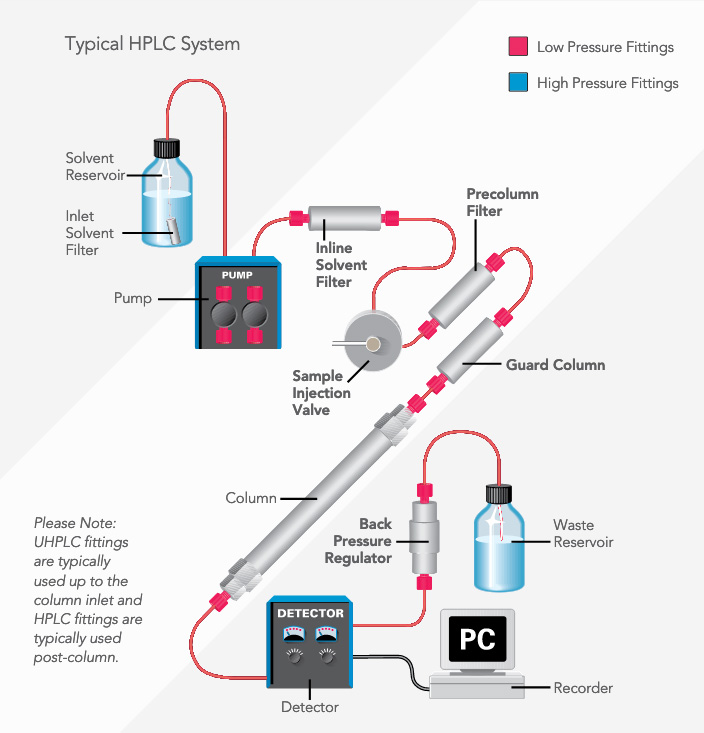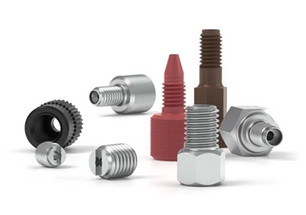Posted by Chrom Tech on 14th Oct 2025
An Essential Guide to HPLC Fittings for Your Laboratory
An Introduction to HPLC Fittings
HPLC fittings play a vital role in chromatography systems, connecting tubing, adapters, and components to ensure leak-free, stable operation. Secure connections are critical for maintaining system pressure, minimizing dead volume, and achieving accurate, reproducible results. In this guide, we’ll review the most common fittings used in HPLC, explain their differences, and highlight how to choose the right ones for your system.
"Creating good connections with fittings is extremely important for successful chromatography."
In most analytical systems, a fitting consists of two main parts: a nut and a ferrule. The nut provides compression force, while the ferrule creates the seal between tubing and connection ports. When selecting fittings, consider factors such as thread type, geometry, tubing size, material, and pressure rating. For an in-depth discussion of fitting types, check out our previous article: What Types of Fittings Are Used in HPLC?
Fittings for Low-Pressure Sections
Although HPLC stands for high-pressure liquid chromatography, not all parts of the system operate at high pressures. The low-pressure areas include:
- The tubing between solvent reservoirs and the pump inlet
- The waste lines following the HPLC column
In these sections, fittings are typically ¼-28 flat-bottom and used with 1/8” OD tubing. Polymeric fittings (such as PEEK) are commonly preferred here because they’re easier to handle, require no tools, and provide excellent chemical resistance for solvent compatibility.
Fittings for High-Pressure Sections
High-pressure areas are generally located between the pump outlet and the analytical column. These connections must withstand the full system pressure—often exceeding 6,000 psi in UHPLC systems. The most common high-pressure fittings are 10-32 coned fittings used with 1/16” OD tubing.
For typical HPLC pressures, polymeric fittings may suffice. However, for UHPLC or other ultra-high-pressure applications, metal nuts and ferrules (usually stainless steel) are strongly recommended to ensure safe, leak-free connections under demanding conditions.
Typical HPLC System Overview
Below is a simplified diagram of an HPLC system, showing where low- and high-pressure fittings are typically used. The low-pressure fittings are used near the solvent reservoirs and waste lines, while the high-pressure fittings are used between the pump and column.

Other Common Fitting Types
In addition to ¼-28 and 10-32 fittings, other fitting types are frequently used throughout chromatography setups:
- Barbed fittings: Ideal for waste lines and non-pressurized tubing connections.
- Luer fittings: Commonly used for connecting syringes to tubing or for quick, low-pressure connections.
- Large-bore fittings: Used in specialized applications requiring higher flow rates or larger tubing diameters.
Chrom Tech offers a complete selection of fittings for both low- and high-pressure connections, ensuring compatibility with virtually any HPLC configuration.
Other Chromatography Consumables to Keep on Hand
Maintaining consistent performance in your HPLC system requires more than just the right fittings. Chrom Tech recommends keeping essential consumables in stock to minimize downtime and ensure smooth operation:
- Chromatography vials and closures
- Sample preparation consumables such as syringe filters and SPE cartridges
- Tubing and fittings
- HPLC columns
- Syringes and sample loops
- Instrument-specific replacement parts
- HPLC solvents and reagents
As a trusted chromatography supplier, Chrom Tech provides the fittings, consumables, and replacement parts you need to keep your lab running efficiently. Reach out to our technical support team for help identifying the correct fittings or replacement components for your specific system.
Frequently Asked Questions About HPLC Fittings
What’s the difference between ¼-28 and 10-32 fittings?
¼-28 fittings are used for low-pressure sections of an HPLC system, while 10-32 fittings are designed for high-pressure applications such as the connection between the pump and column.
Can polymeric fittings handle high pressure?
Polymeric fittings (such as PEEK) are suitable for standard HPLC pressures but should be replaced with stainless-steel fittings for UHPLC or any application exceeding 6,000 psi.
What are the most common materials used for HPLC fittings?
Common materials include stainless steel for high-pressure connections and PEEK for general-purpose or low-pressure applications. Each offers different benefits depending on chemical compatibility and pressure requirements.

